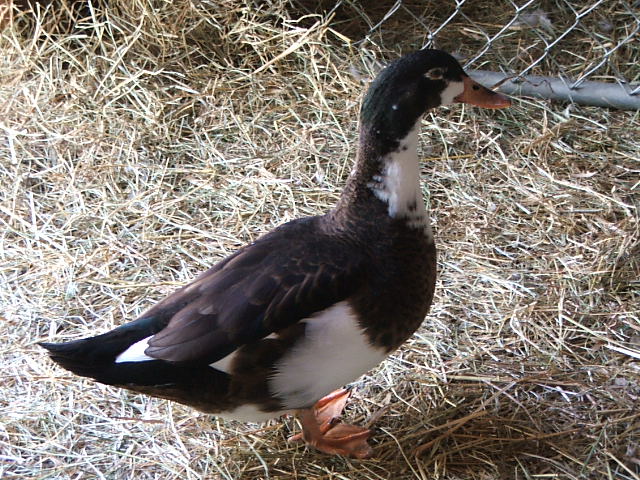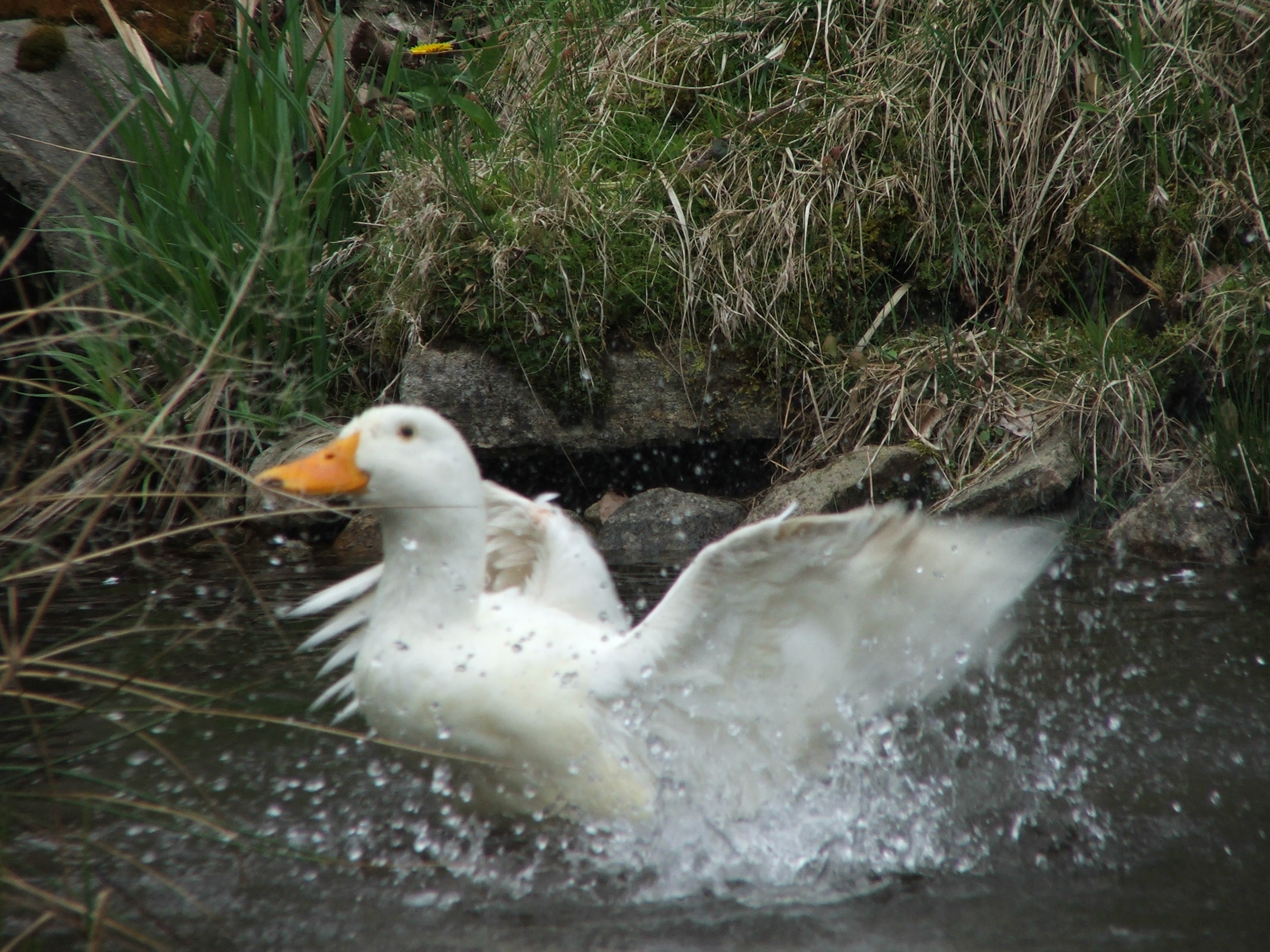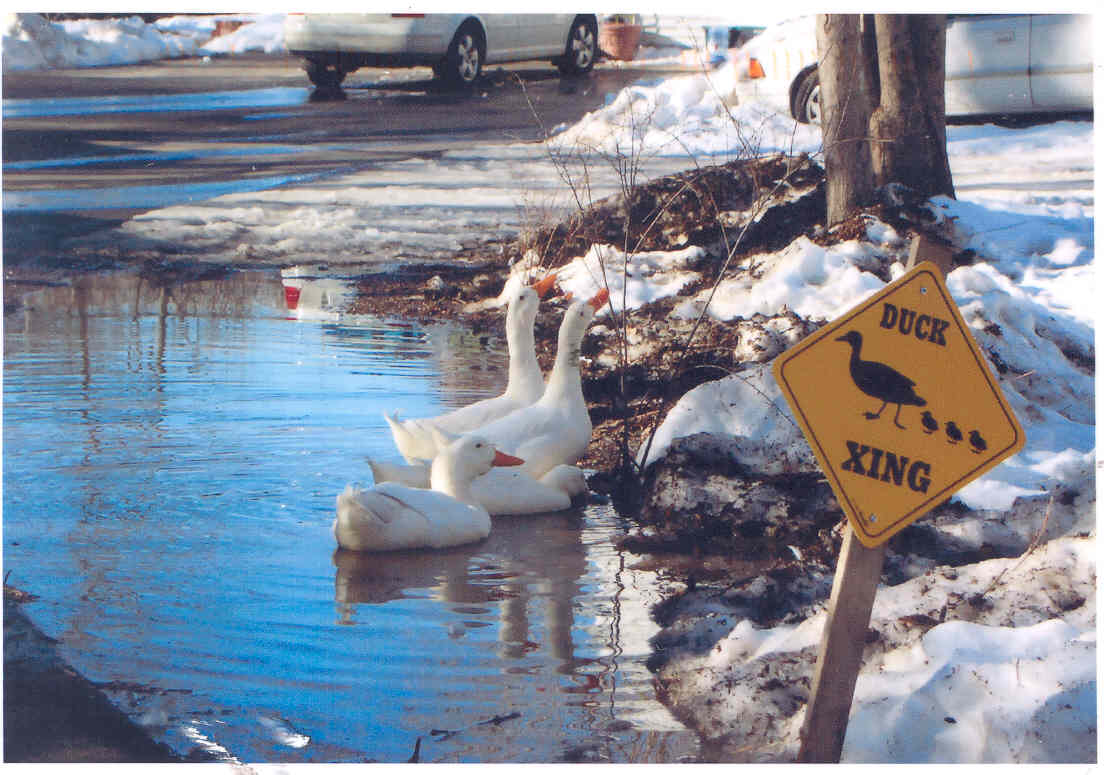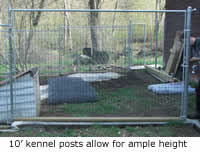|
In This Issue...
 |
Update on Elijah |
 |
Rebuilding our enclosure |
 |
How to build an enclosure |
 |
Digging the Pond |
 |
Get to know your predators:
Coyotes |
 |
Two
Toulouse Geese in Florida need a home |
 |
The Month in Photos! |
 |
Reader Poll #5
|
|
Digging the
Pond
We are thrilled to announce
that we found a local volunteer willing to donate his time
and equipment to dig out the pond in our new enclosure. As
soon as permits are pulled and the June/July draught comes,
we will begin digging. Although his equipment is large
enough to handle the job now, with the stream running, we
need to wait for the dry season to pour the cement basin of
the pond. If you have carpentry skills and are interested in
helping us construct our concrete forms, please contact us
to volunteer.
Get to Know
Your Predators: Coyotes
A Northeastern Coyote weighs in at about
thirty pounds for a female and forty pounds for a male.
They
will hunt nearly any animal that they can overpower.
Coyotes are opportunistic predators, so if they see
something easy to catch, they will attack it. For pet
owners, coyotes are a real danger. They will eat cats
and small dogs. They are also infamous for killing
chickens, ducks and geese. Coyotes are nocturnal and are
most active at night, at dawn, and at dusk.
Coyotes can be heard yipping and howling
near our sanctuary as soon as the sun goes down and then
well into the night. Although some sources will say they
prefer to avoid areas inhabited by humans, we have seen
hungry coyotes gazing through our duck enclosures on a
few occasions. The first time I saw one, I thought I was
looking at a dirty golden retriever with a bushy tail
until I saw the profile of its muzzle. Even when I
barreled down the hill to chase him off, he only moved
away as far as the edge of the lawn. He didn’t leave the
premises until my husband joined me outside and he was
clearly outnumbered.
If your duck enclosure/housing is
inadequate and you have coyotes, you will soon be
without your feathered friends because the coyotes will
continue to return until there is nothing left to take.
In our area, packs come through wipe out all the wild
prey (squirrels, rabbits, foxes) and then move on, only
to return later when prey animals have replenished
themselves.
Coyotes can jump upward over four feet,
and like many dogs have been known to actually scale
fencing, so your fence should be at least six feet tall.
You want a fence strong and tight enough that a
forty-pound coyote can jump up on it, with paws up on
the wire, without causing any damage. Large guard dogs
can be a good deterrent, but remember to protect your
ducks from your dogs.
Two Toulouse
Geese in need of a home in Florida
Update:
A local humane society in Florida has agreed to rescue the
geese and bring them to a farm animal sanctuary to live.
We received an email from a
woman named Jan who is concerned about two Toulouse geese on
a pond in Clearwater, Florida. She tells us the geese were
part of a group of about ten whose numbers have dwindled
over the years due to attacks from stray dogs, coyotes, and
humans.
Jan has contacted a number of
local rescuers and humane societies and none of them are
willing to help. Probably the geese were dumped there by
irresponsible owners who thought they could live in the wild
even though they are farm animals.
The geese she tells us are
quite friendly and thus would be easy to catch. The two
remaining geese are probably male and female as they are
quite bonded.
The Month in
Photos

Talulah arrives!

Elijah flaps his way into recovery!

Photo from Standish's new family
Reader Poll #5
Question: Do you
believe your birds are safe from predators?
Results of Reader
Poll#4 Do you
have a waterfowl or avian vet you can take your duck or
goose to in the event of a medical emergency?
|
Yes |
55% |
| No |
18% |
| I
need to locate one! |
27% |
| |
|
Contact Us
Majestic Waterfowl
Sanctuary
17 Barker Road
Lebanon, CT 06249
directorATmajesticwaterfowl.org
Our Newsletter
The Majestic Monthly is published 12 times per year. Back
issues can be obtained online from our
Newsletter Archives.
|
|
Update on
Elijah
First
and foremost, we would like to extend a very special thank you to
everyone who came forward and donated towards Elijah’s care while he
is in our sanctuary. If you have not yet made a donation and would
like to, please click
here. If you are interested in
sponsoring Elijah while he is in our care, please visit our
sponsorship page.
Elijah was adopted in
February and was brought back to us in April after he and his mate
Lucy were attacked by what is suspected to have been a raccoon.
Elijah sustained serious head, leg, bill, and wing injuries in the
confrontation, but through it all, he hung on. His family brought
Elijah to their veterinarian for emergency care and once stabilized,
they brought Elijah to us to be sure that
Elijah could continue on his path to recovery in the presence of
other ducks. The psychological value of flock-mates is invaluable in
uplifting spirits and encouraging a surviving duck’s will to live.

Elijah was kept in our
infirmary. Shavings were cleaned and changed throughout the day
to ensure a germ-free environment. His trauma was evident by the
pounding of his heart, heard across the room as we handled and
medicated him. He took many baths, which involved filling and
draining the tub multiple times to ensure the cleanest water
possible. Hydrogen peroxide was misted into his non-facial wounds in
an effort to keep them from becoming infected.
Elijah spent the
afternoon and evenings in the company of two feathered volunteers
from our barn. Deirdre, our resident Pekin hen, sat with Elijah for
a few hours in the afternoon and Talulah, a Muscovy hen, enjoyed a
few hours of visitation in the evening. Both hens were placed in
carriers facing Elijah, allowing for visual and vocal contact, but
preventing any stitch-pulling mishaps.
Every day that passed
was another good day, but the milestone was getting him to survive
through the first weekend. Elijah’s fear began to fade and his
heartbeat could no longer be heard pounding through his chest during
medication times. By Saturday afternoon, he was able to spend a few
hours in a kennel in the barn, padded with a thick layer of clean
shavings. By the time Sunday came around, he had made the permanent
move to the barn.
Elijah went to see our
vet the Monday after his arrival, and we are happy to say that the
news was good. No sign of infection was present. He was given the
“You’re one very lucky duck,” and sent home to continue his round of
antibiotics. As long as we don’t experience any setbacks, Elijah
will be receiving follow-up vet care on a bi-weekly basis for
continued monitoring. Once he is in a safe point of his recovery,
our vet believes that the broken tip of Elijah’s upper bill will
need to be trimmed and cauterized to avoid further damage.

We would like to thank
Elijah’s family for sparing no expense in providing all of his
initial life-saving medical care. We are also in their debt for
recognizing that, above all, his recovery was dependant upon the
company of other ducks. We know how difficult it is to part with a
beloved pet, but their sacrifice has ensured Elijah’s survival. No
duck should be alone. Our deepest regrets to his family for their
loss of Lucy; she was a beautiful and friendly lap duck who we truly
enjoyed meeting. Lucy’s photograph can be seen with Elijah in our
March newsletter.
In the days and weeks to
come, we will continue to post photos and bring you updates
regarding Elijah’s recovery.
Rebuilding our small
waterfowl enclosure
Our
small 25’ x 25’ sanctuary, constructed of 4’ x 4' pressure treated
wood and galvanized wire, gave out in the last snowstorm (the ducks
were safely in the barn, of course). We completely tore it down in
March and have been rebuilding and enlarging it over the last few
weeks.

The new enclosure
measures 25’ x 35’ and is constructed of a concrete perimeter, steel
kennel poles, wire mesh underground predator barriers, a poultry
wire aviary net, and concrete swimming basins. Once the new pond is
completed in the larger enclosure, water will be pumped up into
these cascading concrete basins enabling fresh water to flow through
on a whim. The enclosure can easily be divided into three
decent-sized sections to accommodate separations. Each section also
has a little house, providing shelter from rain and sun.
How to build a safe
enclosure for waterfowl
Since
opening, one of the questions we are frequently asked is how to
build a safe enclosure for ducks and geese. Many waterfowl owners
are interested in knowing the type of enclosure they need to build
for their pet ducks and geese in order to keep them safe from
predators.
Detailed below
are step-by-step instructions for an easy-to-build, quick, and
affordable DAYTIME enclosure for ducks and geese. Ducks and geese
need to be locked up at night to be kept safe; ideally the nighttime
enclosure (typically a small lockable house or shed) can be situated
right inside the daytime enclosure, offering a double-barrier
against predators. It also makes the task of rounding up your birds
and getting them in the nighttime enclosure a lot easier.
Friendly Reminder: All gates and
doors of both daytime and nighttime enclosures should be sealed
tight with padlocks. Some predators, such as raccoons (and
neighbors), have very
agile “fingers” and are excellent at opening latches.
Step-by-Step
Instructions for Daytime Enclosure
- Draw your
plans on paper.
- Measure
and spray paint your floor plan for the enclosure onto the
ground
- Dig an
18-inch trench where your enclosure’s perimeter will be.
- Space and
sink kennel posts (we used 10’ kennel posts) into the ground
along your perimeter, in your18-inch trench. The spacing in
between the perimeter posts will be determined by the length of
the kennel top & bottom rails you choose (we used 10’ rails).
Sink the posts into the ground and pour Quikcrete (premixed
cement) around them to hold them firmly in place. Allow cement
to dry thoroughly. Don’t forget to plan for a gate!

- Assemble
bottom kennel rails by connecting them with kennel hardware to
the bottom of the sunk-in perimeter posts. The bottom rails are
laid down in the 18” perimeter trench.
- Assemble
your top kennel rails by connecting them with kennel hardware to
the tops of the perimeter posts.
- Weave your
aviary net. You can weave your own aviary net VERY inexpensively
and VERY easily—and a good sturdy one at that. Purchase one-inch
(hole), galvanized poultry wire and cut it to the size of your
enclosure, then sew it together using tie wraps.
For Example: If your
enclosure will measure 20’ wide by 25’ long, you would need to
buy a single roll of 4’x 100’ galvanized, one-inch (hole)
poultry fence and a single roll of 4’x 25’ fence (approximately
$50 total). Cut the rolls into five sections, each measuring 25’
in length. Lay the five lengths of fence out in a giant 20’ x
25’ square and then tie wrap the sections together. Place a tie
wrap about every 4-5 inches apart to sew your five sections
together. It's easy to do and it moves along fairly quickly. BE
SURE TO DO THIS ASSEMBLY INSIDE OF THE ENCLOSURE’S PERIMETER, to
prevent you from having to drag it in through the gate later.
Keep it laid out on the ground in the enclosure; you can walk on
it while you are working through the remaining steps.
- Wire the
perimeter fencing firmly and tautly to the perimeter posts. Make
sure the fencing you choose is rustproof and cannot be bitten
through. We recommend a thick, galvanized, and (if possible) pvc-coated,
wire fencing. Make sure the mesh of the wire is tight enough to
stop predators from crawling through the holes. Both raccoons
and weasels have been known to gnaw through poultry wire, so you
may need to shop around to find the best barricade for your
area’s predators. You may also find it necessary to double
fence; that is, to put up two types of mesh fencing to
compliment each other and strengthen the barrier between your
waterfowl and potential danger.
- Dig a
ditch on the outskirts of your perimeter, like a moat. The ditch
should go down six inches and extend outwards at least two feet.
This will be your digging predator barrier. Place welded “rabbit
wire” mesh down in the ditch. Fasten one end of the wire to the
bottom rails of the perimeter. Cover the wire mesh with dirt and
replace sod or plant grass seed to hide the wire mesh.
- Cover the
bottom kennel rails of your perimeter, filling the 18” trenches.
Plant grass.
- Wire the
aviary net to the top rails of the perimeter fence. Put up
prop-up poles inside of the enclosure, about every 5-6 square
feet as needed to raise the net up. Make the poles tall enough
for comfortable entry, so you are not bumping your head. We used
5" diameter tree trunks as prop-up poles to give the enclosure a
more natural look (and to save money!).
- Set up a
kiddy pool and a shelter/house.
|